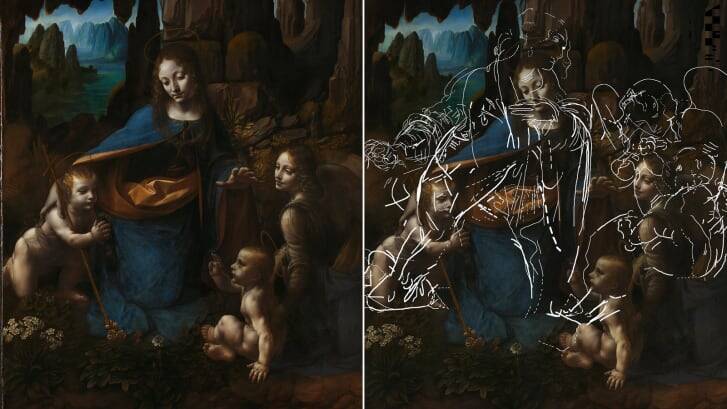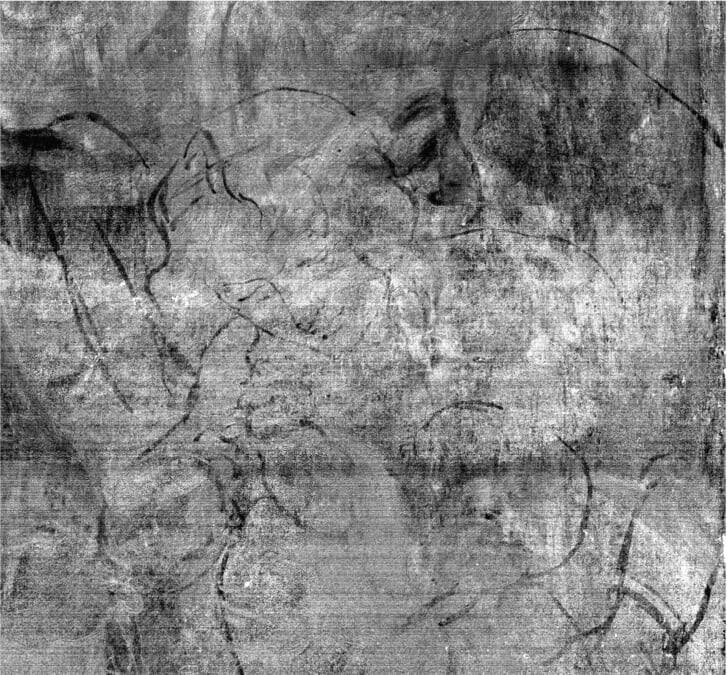Advanced technology has detected the sketch of a Leonardo Da Vinci masterpiece hidden beneath the finished product as well as the artist’s own handprints.

The National GalleryThe finished painting (left) and Leonardo Da Vinci’s considerations mid-work in sketch form on the right.
Museumgoers at London’s National Gallery have likely walked by and marveled at Leonardo Da Vinci’s 15th-century painting “The Virgin of the Rocks” without a clue as to what lay beneath. As it turns out, for the past 500 years, neither did anyone else.
According to CNN, a recent scientific analysis of the painting using new infrared and hyperspectral imaging revealed Da Vinci’s handprints and early sketches of the work underneath the final product.
The faint sketches show the angel and Baby Jesus in slightly different positions. Experts believe that Da Vinci later altered the final angle from which Christ was depicted in order to show the figure more clearly from a profile perspective.
“In the abandoned composition both figures are positioned higher up, while the angel, facing out, is looking down on the Infant Christ with what appears to be a much tighter embrace,” the National Gallery said in a statement.
According to LiveScience, the imaging process used to discover what lay beneath the finished painting was quite technologically sophisticated. Though researchers detected the tracings of a covered-up underpainting as early as 2005, modern tech has elucidated the work more clearly than ever before.
A segment by The Telegraph on the two versions of ‘The Virgin of the Rocks.’
In order to fully reveal the underpainting, researchers used a combination of infrared reflectography, X-ray fluorescence (XFR) scanning, and hyperspectral imaging. The first technique was employed back in 2005 when researchers discovered that there was possibly an underpainting in the first place.
Even though the brushstrokes were covered by numerous layers of paint and were thus invisible in the visible spectrum, they weren’t hidden from infrared light. XFR scanning, meanwhile, illuminated useful individual elements when hit with X-ray light.
“These new images were found because the drawings were made in a material that contained some zinc, so it could be seen in the macro X-ray fluorescence (MA-XRF) maps showing where this chemical element was present, and also through new infrared and hyperspectral imaging,” the gallery said.

Wikimedia CommonsTwo versions of the painting exist and are referred to as the Paris version (1483–1486)(left) and the London version (1495–1508)(right). The hair of the two infants was clearly changed between versions, as well as the colors. The sketch beneath the London version reveals Da Vinci’s considerations mid-progress of the final product.
Hyperspectral imaging, which detects the electromagnetic energy emanating from a subject across a variety of spectra, made the finer remaining details visible. This technique allowed for nuances that are not detectable in any one single spectrum to be seen.
The scene depicted in the painting, which shows the Virgin Mary, Baby Jesus, and an infant Saint John the Baptist, is the second version Da Vinci made. He sold the first one (which dates to around 1483) to a private client and is currently on display in the Louvre.
The sale was made during a dispute with a church that was keen on owning the painting. The underpainting found here showed a notable departure from the original. The final version skews much closer to the original — and was eventually sold to the church.
“This second version is no mere reproduction, however,” said the gallery. “Along with significant adjustments to the figures, he also uses this version to explore new kinds of lighting effects based on his own research into optics and the physiology of human vision.”

The National GalleryThe first evidence of a hidden underpainting was found in 2005. Since then, X-ray fluorescence scanning and hyperspectral imaging were used to garner a fuller picture.
As it stands, the National Gallery said there was a possibility of even more details being revealed in the near future.
The data processing of this recent scientific analysis is still underway, and with “The Virgin of the Rocks” scheduled to appear at the gallery’s new “Leonardo: Experience a Masterpiece” exhibition from Nov. 9 to Jan. 12, 2020, time is certainly of the essence.